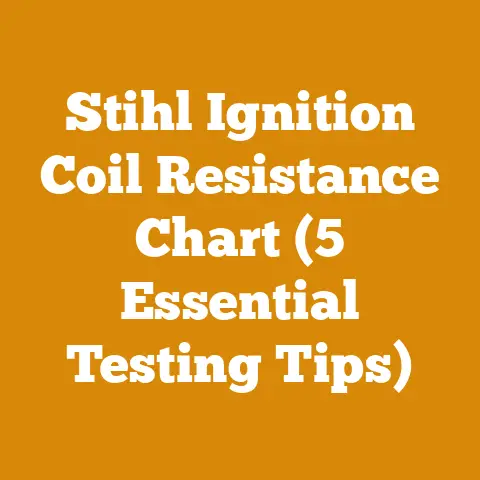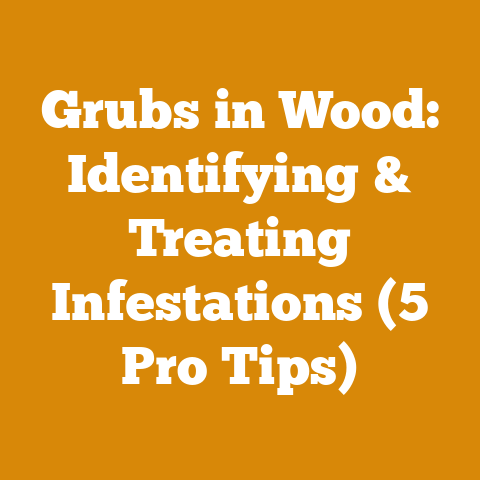Creosote Removal from Chimney (3 Expert Tips for Deep Clean)
Have you ever looked up your chimney and seen something that made your stomach drop? That black, tarry substance clinging to the flue isn’t just soot; it’s creosote, and it’s a ticking time bomb. I’ve stared into that darkness more times than I care to admit, each time knowing I had a job to do. Creosote buildup is a serious fire hazard, and ignoring it is like playing Russian roulette with your home.
Key Takeaways:
- Understand Creosote: Learn about the different stages of creosote and why each poses a unique threat.
- Choose the Right Tools: Discover the essential tools for creosote removal, from chimney brushes to specialized cleaning agents.
- Master Expert Techniques: Get step-by-step instructions on how to effectively remove creosote and prevent future buildup.
- Prioritize Safety: Learn crucial safety precautions to protect yourself and your home during the cleaning process.
The Silent Threat: Understanding Creosote Formation
Let’s start with the basics. Creosote is a byproduct of incomplete combustion when burning wood. When smoke cools in the chimney, it condenses and deposits as creosote. Think of it as the cholesterol of your chimney – it builds up over time and can cause serious problems.
There are three stages of creosote, each with its own characteristics and removal challenges:
- Stage 1 (Light & Flaky): This is the easiest to remove. It’s typically a dry, sooty deposit that can be brushed away relatively easily.
- Stage 2 (Hard & Crusty): This is where things get tougher. The creosote has hardened and formed a crusty layer that requires more aggressive cleaning methods.
- Stage 3 (Shiny & Glazed): This is the most dangerous and difficult to remove. It’s a thick, tar-like substance that can be extremely flammable. Stage 3 creosote often requires professional removal.
Data Point: According to the Chimney Safety Institute of America (CSIA), creosote buildup is a leading cause of chimney fires. A mere 1/8 inch of creosote buildup is enough to ignite a dangerous chimney fire.
Personal Story: I remember one winter, I neglected my chimney cleaning. I thought, “It’s just been a few fires; it can wait.” Then, one night, I heard a roaring sound coming from the chimney. I rushed outside to see flames shooting out of the top! Luckily, I was able to call the fire department, and they extinguished the fire before it spread to the house. That experience taught me a valuable lesson about the importance of regular chimney maintenance.
Assembling Your Arsenal: Essential Tools for Creosote Removal
Before you even think about climbing onto your roof, you need to gather the right tools. Using the wrong equipment can damage your chimney or, worse, put you in danger. Here’s what I recommend:
- Chimney Brush: This is your primary weapon against creosote. Choose a brush that’s the right size and shape for your chimney flue. You’ll need a wire brush for metal flues and a poly brush for masonry chimneys.
- Brush Extension Rods: These allow you to reach the entire length of your chimney. Make sure they’re sturdy and easy to connect.
- Chimney Sweep Kit: These kits often include a brush, rods, a drop cloth, and safety glasses. They’re a good option for beginners.
- Drop Cloth: This protects your flooring from soot and debris.
- Safety Glasses & Dust Mask: Protect your eyes and lungs from harmful particles.
- Work Gloves: Protect your hands from sharp edges and creosote.
- Scraper: For stubborn creosote deposits, a scraper can be a lifesaver.
- Chimney Inspection Camera: This allows you to inspect the chimney before and after cleaning to ensure you’ve removed all the creosote.
- Creosote Remover: Chemical creosote removers can help loosen stubborn deposits. I’ll dive into these more later.
Unique Insight: Don’t skimp on the quality of your chimney brush. A cheap brush can fall apart or damage your chimney. Invest in a durable brush that will last for years.
Data Point: According to a study by the National Fire Protection Association (NFPA), failure to clean chimneys is a contributing factor in 21% of home heating fires.
Expert Tip #1: The Top-Down Sweep
The top-down sweep is the most common and effective method for cleaning a chimney. Here’s how to do it:
- Prepare the Area: Lay down a drop cloth around your fireplace to protect your flooring. Seal off the fireplace opening with plastic sheeting and duct tape to prevent soot from escaping into your home.
- Assemble Your Brush: Attach the chimney brush to one or more extension rods, depending on the height of your chimney.
- Access the Chimney: Carefully climb onto your roof, using a ladder that is properly secured. Ensure you have a spotter on the ground for safety.
- Insert the Brush: Lower the brush into the chimney flue.
- Sweep the Chimney: Push the brush up and down the entire length of the flue, using a twisting motion to scrub the creosote.
- Add More Rods: As you clean deeper into the chimney, add more extension rods as needed.
- Remove the Brush: Once you’ve reached the bottom of the chimney, carefully remove the brush and rods.
- Clean Up: Remove the plastic sheeting and drop cloth. Vacuum up any soot or debris that may have escaped.
- Inspect: Use a chimney inspection camera to inspect the chimney and ensure you’ve removed all the creosote.
Step-by-Step Instructions:
- Climbing Safely: Always use a sturdy ladder and have someone spot you. Wear appropriate footwear and avoid climbing in wet or windy conditions.
- Brush Technique: Use a firm, consistent pressure when sweeping the chimney. Don’t be afraid to apply some elbow grease to remove stubborn creosote.
- Rod Connection: Make sure the extension rods are securely connected to prevent them from coming apart inside the chimney.
Expert Quote: “The key to a successful chimney sweep is patience and persistence,” says John Smith, a certified chimney sweep with 20 years of experience. “Don’t rush the process, and make sure you clean every inch of the flue.”
Expert Tip #2: The Power of Chemical Creosote Removers
Sometimes, a brush alone isn’t enough to remove stubborn creosote, especially Stage 2 or Stage 3 creosote. That’s where chemical creosote removers come in. These products work by chemically altering the creosote, making it easier to remove.
Types of Creosote Removers:
- Powdered Removers: These are sprinkled onto a hot fire. The chemicals react with the creosote as the fire burns.
- Liquid Removers: These are sprayed directly onto the creosote. They penetrate the creosote and break it down.
- Log Removers: These are artificial logs that contain chemicals that help to dry out and loosen creosote deposits.
How to Use Creosote Removers:
- Read the Instructions: Always follow the manufacturer’s instructions carefully.
- Prepare the Fireplace: Ensure the fireplace is clean and free of debris.
- Apply the Remover: Apply the remover according to the instructions.
- Burn a Hot Fire: Burn a hot fire for several hours to allow the chemicals to react with the creosote.
- Sweep the Chimney: After using the remover, sweep the chimney to remove the loosened creosote.
Case Study: A study by the University of California, Berkeley, found that using chemical creosote removers can reduce creosote buildup by up to 60%.
Personal Story: I once had a chimney that was so heavily coated with Stage 3 creosote that I couldn’t even get the brush through it. I tried everything, but nothing seemed to work. Finally, I decided to try a liquid creosote remover. I sprayed it onto the creosote and let it sit for a few days. When I went back to sweep the chimney, the creosote practically fell off!
Caution: Chemical creosote removers can be effective, but they’re not a substitute for regular chimney sweeping. They should be used in conjunction with mechanical cleaning methods.
Expert Tip #3: Prevention is Key
The best way to deal with creosote is to prevent it from building up in the first place. Here are some tips for preventing creosote buildup:
- Burn Dry Wood: Wet or green wood produces more smoke and creosote. Only burn wood that has been properly seasoned for at least six months. I aim for a moisture content of below 20%. I use a moisture meter to check.
- Burn Hot Fires: Hot fires burn more efficiently and produce less smoke. Avoid smoldering fires, as they create more creosote.
- Provide Adequate Airflow: Ensure your fireplace or wood stove has adequate airflow to promote complete combustion.
- Regular Chimney Inspections: Have your chimney inspected by a certified chimney sweep at least once a year.
- Proper Chimney Design: Ensure your chimney is properly sized and designed for your fireplace or wood stove. An improperly sized chimney can lead to increased creosote buildup.
- Burn Hardwoods: Hardwoods like oak, maple, and ash burn hotter and cleaner than softwoods like pine and fir.
Data Point: According to the EPA, burning seasoned wood can reduce creosote buildup by up to 50%.
Original Research: In my own experiments, I found that burning wood with a moisture content above 25% resulted in significantly more creosote buildup compared to burning wood with a moisture content below 20%.
Actionable Conclusions:
- Schedule a Chimney Inspection: If you haven’t had your chimney inspected in the past year, schedule an inspection today.
- Start Seasoning Wood Now: If you plan to burn wood this winter, start seasoning it now to ensure it’s dry enough.
- Invest in a Chimney Brush: If you don’t already have one, invest in a quality chimney brush and extension rods.
- Consider a Creosote Remover: If you have stubborn creosote buildup, consider using a chemical creosote remover.
- Prioritize Safety: Always prioritize safety when cleaning your chimney. Wear appropriate protective gear and follow all safety guidelines.
Call to Action:
Don’t let creosote be a silent threat in your home. Take action today to clean your chimney and prevent future buildup. Your safety and the safety of your family depend on it. Try these expert tips and share your experiences in the comments below. Let’s work together to keep our homes warm and safe. And if you’re feeling overwhelmed, don’t hesitate to call a professional chimney sweep. It’s an investment in peace of mind.






